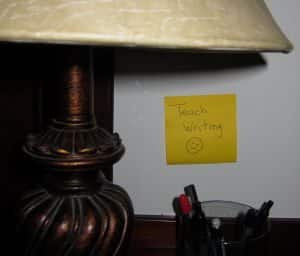Teaching Writing in Your Homeschool – It’s Not That Complicated
By Harriet Yoder, Lamp Post Homeschool Store
Frequently homeschool parents ask about teaching writing. Usually it is based on a fear the child will not be able to write because, well, he is not writing anything wonderful yet. Here is what we suggest for teaching writing – it’s not that complicated.
Young Children and Writing

When they were young, we read aloud to our children; taught each one to read; and chose great books for them to read. We did not push them to write/compose papers until they were in junior high and high school. The ones who graduated have gone on to college and are very good writers.
I like the Charlotte Mason method of reading well-written books because hearing or reading a great author’s style and language patterns etches them onto a child’s brain. Children who are well read are usually excellent writers.
Can your child read a story or book and tell you what happened in his own words?
If so, why are you worried? If your child retells the story in the right sequence with accurate facts, your child is composing on the fly as he narrates back to you. It is writing without the worry of spelling, handwriting, and grammar.
In the early grades, I ask the child to narrate something to me while I write or type it. Then I ask the child to copy it in his handwriting. This separates the creative task of composing from the technical tasks of handwriting, spelling, and grammar.
How can you expect a young child to compose and create while remembering how to make letters, spell, punctuate, and so on? I have not seen many who can. That is why it is better to wait until the child is older to combine the technical side with the creative side.
What are the technical aspects of writing?
The technical aspects of writing are the things your child learns by repetition and memorization: handwriting, spelling, grammar. You teach the mechanics of writing with different language arts courses. Your student also learns the technical aspects by “osmosis” through reading good literature. An example of this type of osmotic learning is looking at a word and knowing it is misspelled. Sometime in the past, your brain stored the word from something you read. Each year from kindergarten to twelfth grade, your child is learning the basic technical tools of writing and composing.
How do I teach writing to older students?
I have seen the courses that teach one to take a basic sentence and add beautiful adjectives and adverbs to make it wonderful. Yes, there is a point to using a thesaurus to find better words for what you are trying to say, but teaching writing as if you are putting together a bunch of building blocks seems mechanical to me.
My mother taught high school and college English. She worked with each of us when we were in high school and had papers to compose. Each of her children has a unique writing style and uses it in real life.
To start the creative juices flowing, her method consisted of asking questions about what I needed to write. I stood by her desk as she posed different questions and typed my answers. Then we would refine and edit together. Repeatedly we did this but sometimes she would be busy and ask me to work alone until she could help. Making me write on my own worked. She passed along ownership of the writing process. As if she were standing beside me, I can still hear her voice prompting me as I write.
It’s Not That Complicated.
If your child is reading great literature, narrating to you, and learning the mechanics of writing, it’s not that complicated to teach the writing process. After all, you have twelve wonderful years to equip them with good language skills, listen to their stories, and encourage them to read great literature.
Keep on homeschooling!









Great article!! I also believe that reading great literature was the defining point for teaching my own children to write and also how to think creatively. When they were younger I used to have them narrate their stories to me while I wrote it, however if only I would have had them copy it in their own handwriting, I might have had children whose handwriting looked better. I guess I’ll pass on this advice to them when they homeschool their own children.
Good article, for me as we’ll it came at a time where I’m trying to make it the easiest for my 2nd grader. Im rethinking and rethinking how much i should make him write.. You wrote that when yours were smaller you’d ask the child to narrate something to you while You wrote or typed it. Then ask the child to copy it in his handwriting. I do the exact same thing. My question: how much would you make them write on a daily basis?
In 2nd grade I would suggest doing a few sentences a few times a week. It’s not necessary to write down all of his narrations for him to copy. A 2nd grader is still in the absorbing stage where he’s acquiring language skills from listening and reading.
I tend to focus more on the verbal interactions we have as we read aloud or do science or history lessons together.
That brings up the concept of integrating the subjects which is more “real life” to me. For example, if you just read a great book about butterflies (science), have your child narrate and write it down. He just covered science and language arts.
Hope this helps!
Thank you for the reply Harriet, I’m taking it all in *smile* I thought it would be beneficial for him to narrate, for me to copy and for I’m to write it in his history/ science or open reading notebook. Specially in open reading though it does take the fun of it.. Maybe I feel that if its not written down it won’t be retained.. ? So it’s really good getting to read how others do it.
Myriam, you are definitely on the right track!
I agree great literature is key. We read aloud to our children every day. I also agree composition and prompt writing does not work well with young children.
We do daily journal writing. The children started journals full of scribbles when they were toddlers. The journals have grown into special memory books that chronicle our day to day life. I have a series of post on introducing children to journal writing from toddlers to third grade. Reading and writing is a part of our routine in our homeschooling day. http://waddleeahchaa.com/2010/08/30/10-easy-steps-to-introduce-journal-writing-preschool-third-grade/
I LOVE reading your articles around the web, Harriet, because I love your ‘laid back’ approach! It can be so hard for a homeschooling Mama to do all that she thinks she “should” be doing and you always remind us to just let the learning occur naturally. It is so refreshing to hear “You’re doing fine. They will get it when they’re ready.” Thanks so much for all that you do!
Thank you, Tiffany. Sometimes I think the hard part for “homeschooling Mamas” is that if we went to public school, we tend to make that experience a benchmark and compare our homeschooling. That is a fail because the success rate for homeschool graduates is much higher than for public school graduates.
http://www.nheri.org/research/research-facts-on-homeschooling.html
Take it from a veteran “homeschooling Mama,” You’re doing fine, ladies!
I wrote a post on kids and writing. I like my kids to write everyday–it might just be a handwriting page or helping me with the grocery list. My son does not like to write nor does my youngest with fine motor skill issues–so I film them on the iPhone or the Flip camera and they love to watch themselves OR they create stories and film them. Then they love watching themselves.
Be blessed.
Renee, I think it is a great idea to incorporate writing into real life activities! Using the iPhone or Flip camera to inspire them is very creative. Thanks for commenting.
I love teaching Writing with the 6+1 Traits of Writing by Ruth Cullum. The best book is the Primary Grades book and there is a Using Picture Books to Teach Writing that perfectly complements it.
I used 6+1 when I was teaching at a private Montessori and in public school (elementary – middle) and now that I will be homeschooling my own little guy starting in January.
6+1 uses a lot of picture books you can find at the library, is so creative (not just writing stories, paragraphs, etc.) but using writing for so many things! The 6 traits covers everything you need to cover in writing from Ideas to Mechanics and everything in between. You can use it for K up through high school.
It looks like an interesting book. I’ll check it out. Thanks!
Time4Writing offers lots of great free teaching resources for helping your child learn to write. I’ve found good stuff there.
I think they start at second grade, but I do know they go up to high school level and beyond. My daughter is in high school, but I believe I saw stuff for younger kids too.
Joyfully,
Jackie
This is in fact my son’s biggest struggle. I can not figure out how to get him to the writing stage. He simply stares into space and the more I try to encourage the more he shuts down. If I give him prompts he just writes what I have prompted. For a while illustration worked. He would draw the story then go back and write what the drawings were about, but it was quite simple without much in the way of descriptions. Even basic sentences are a struggle for him to “free think.”
He excels in most other areas of learning, but writing for him is THAT COMPLICATED.
Renee, I can understand your frustration. It sounds like you have tried many different things to motivate your son. In this article I didn’t talk about children who might have learning problems. Sometimes writing problems can be due to a learning disability. Thus, there may come a time when diagnostic testing is needed to rule out a learning disability.
For example, I had a friend whose homeschooled son struggled for years with reading. He knew every phonics sound, but still could not read. She finally had him evaluated for reading problems by a professional. The diagnosis was that he couldn’t process blending and thus would never be able to learn to read with phonics. And even if he memorized sight words, reading would never be strong point for him.
In my friend’s case, it was a relief to know that there was a real problem. She signed her son up with a program that allows her to request books he needs tor school in an audio format so he can read along in the book. He qualified for this special service because they had the professional diagnosis. They are both happier with his homeschool work now.
It also might be age related if your son is in an elementary grade. If that’s the case, keep on working with him and wait for it.
Hope this helps.
Renee, try http://www.homeschoolwriter1.com. Also, ask your son to click on “Your 16 Minutes of Fame.” If he likes the idea, send me an email and we can set it up. It will let him sound off about his thoughts on writing. If he wants, I’ll publish the interview (phone, recorded, transcribed) on the site, and change the page to, “(your son’s name) 16 Minutes of Fame.” In the interview, I’ll simply ask him to chat about writing, the good, the bad, the frustrating, etc. The key to learning to write is first to find out why your son finds writing to be “complicated.” As your son is good in other topics, there’s a way to blend writing with the “other” topic.
Lee
You have provided some wonderful suggestions! I love the idea of separating the mechanics from the creativity at the very young ages. I would suggest that part of the writing process is less organic when papers become longer and certain products (lab reports, resumes) become more “boring” as students are older. I think it’s important to also remind them that writing is a process and that the work they produce will not be a perfect polished piece all at once. Re-writing, proofing, and letting ideas “simmer” will help students produce great writing with pride.